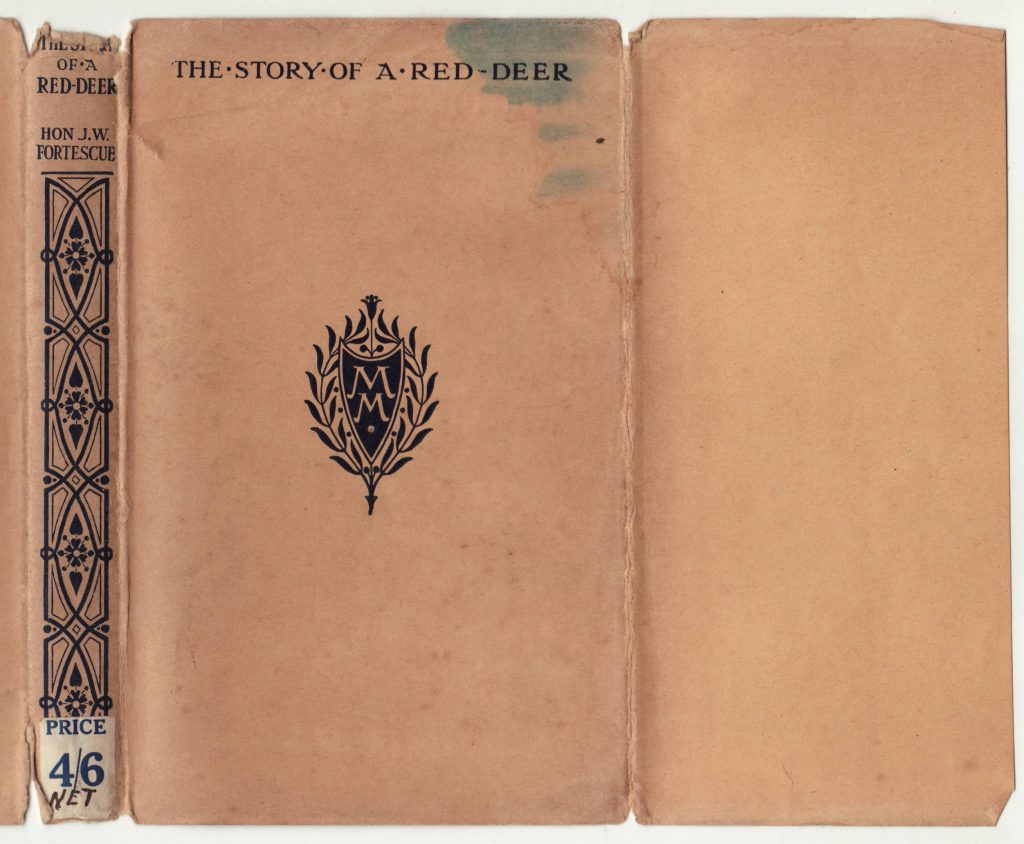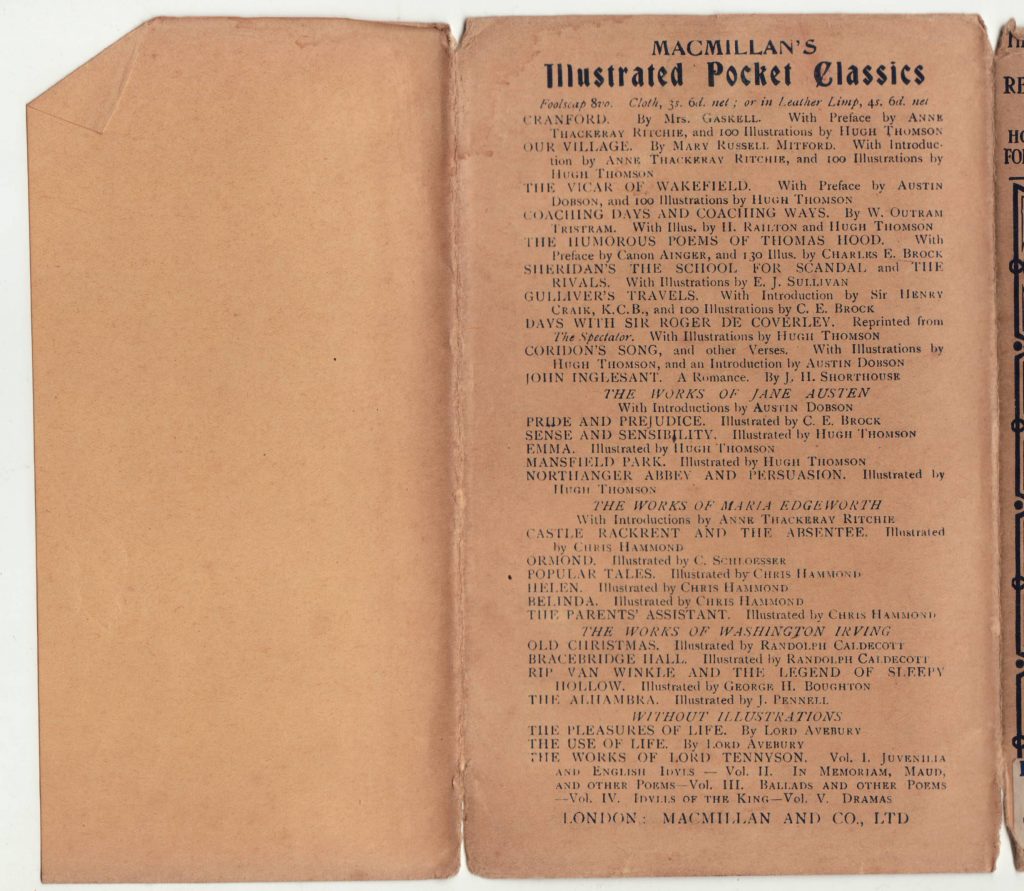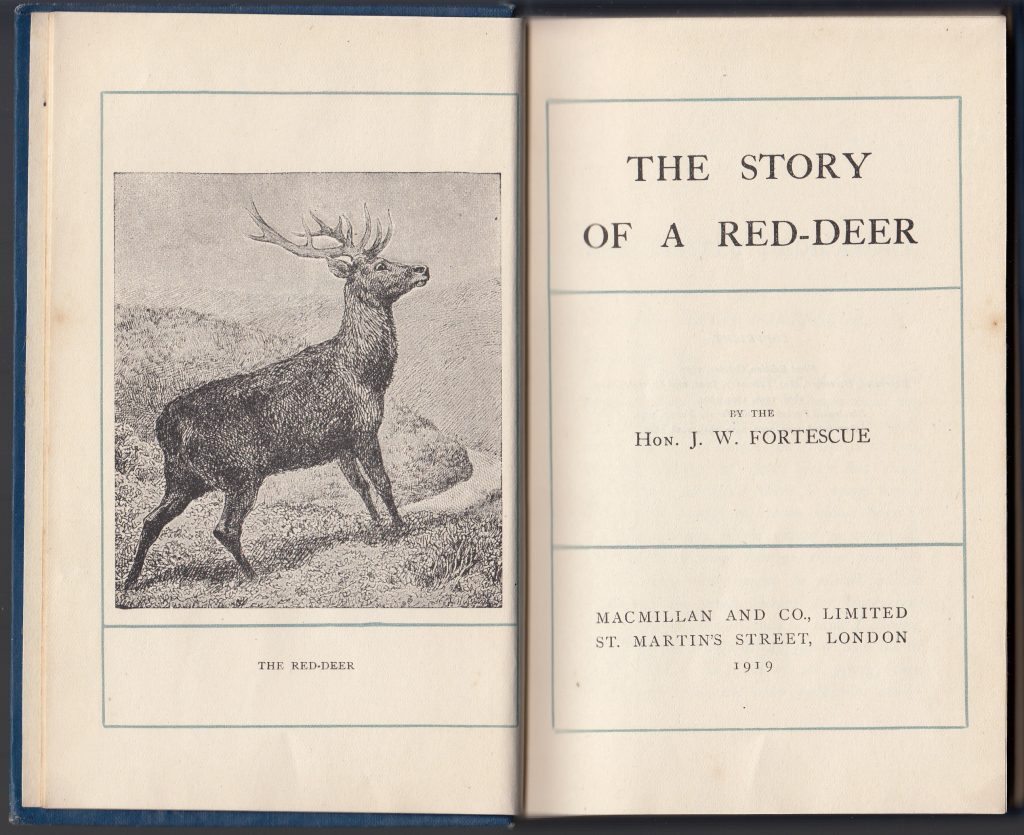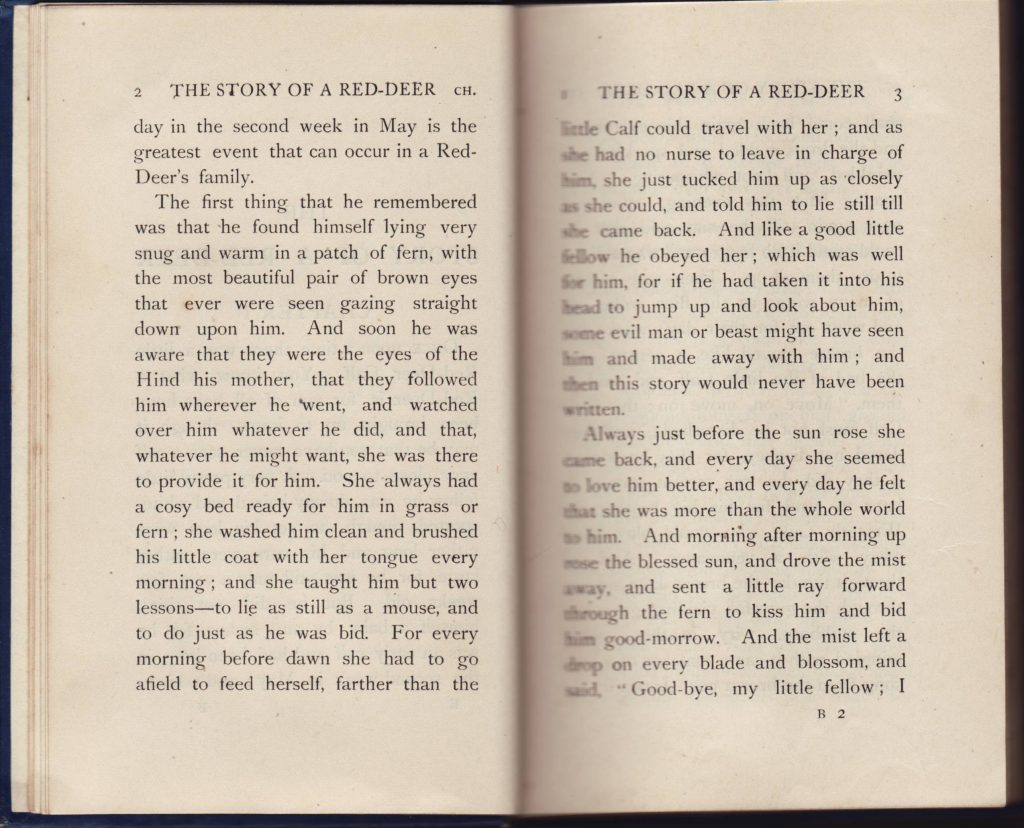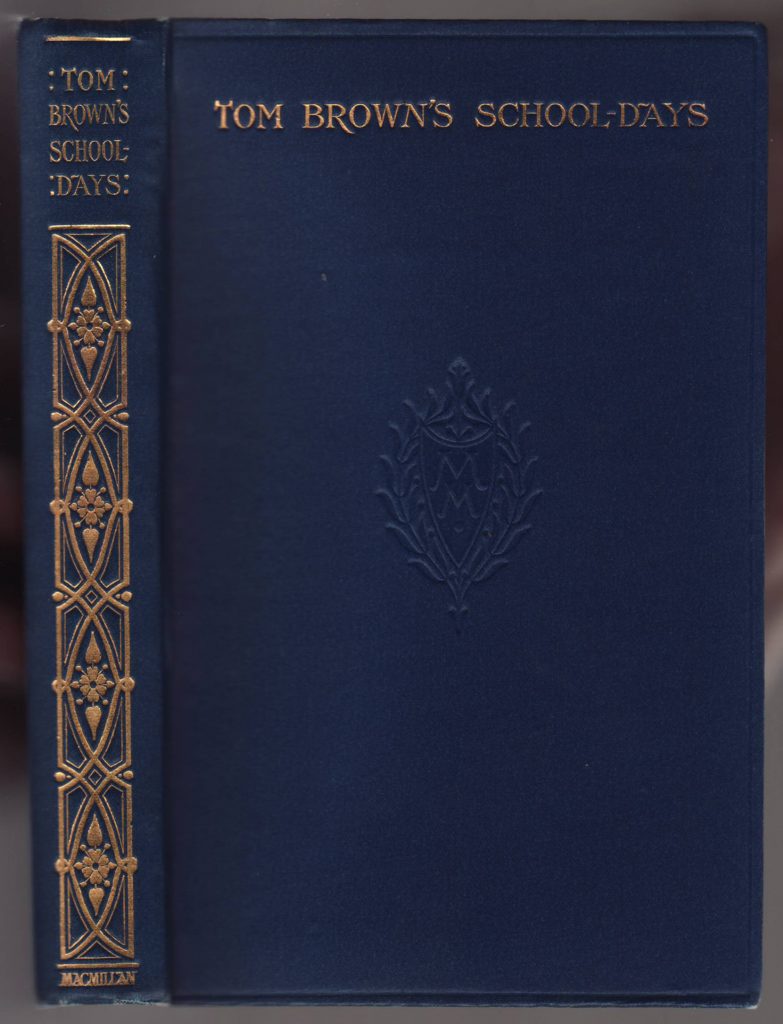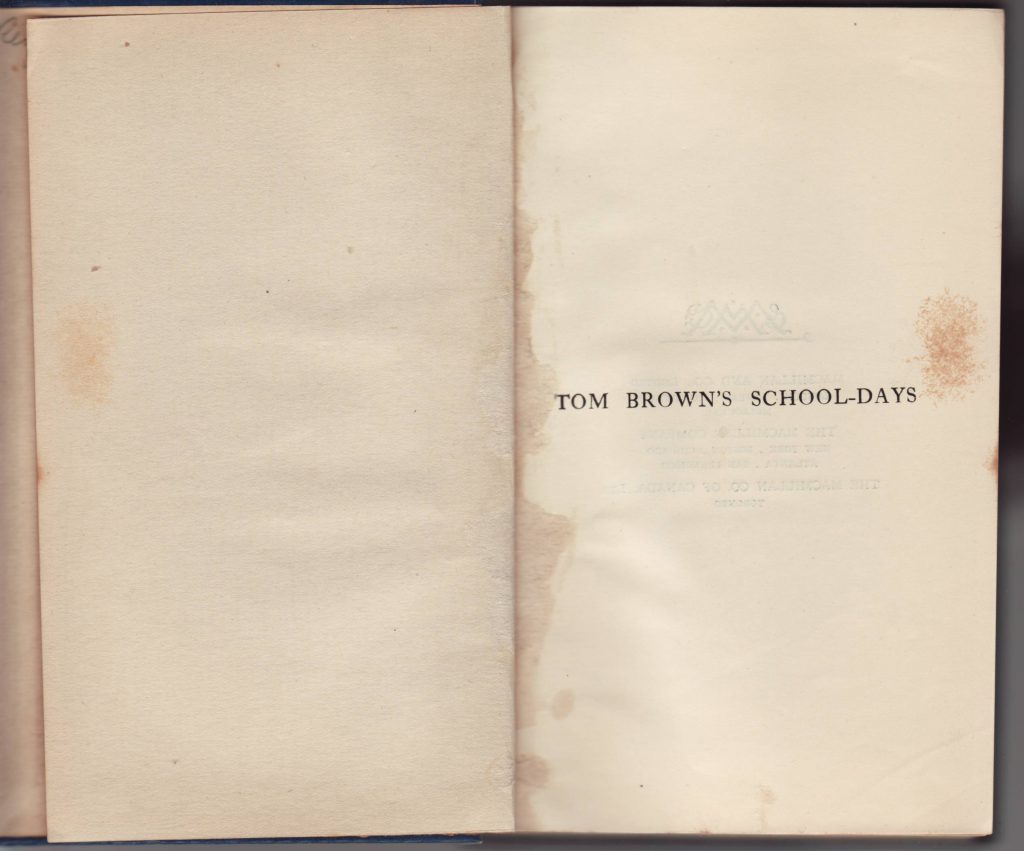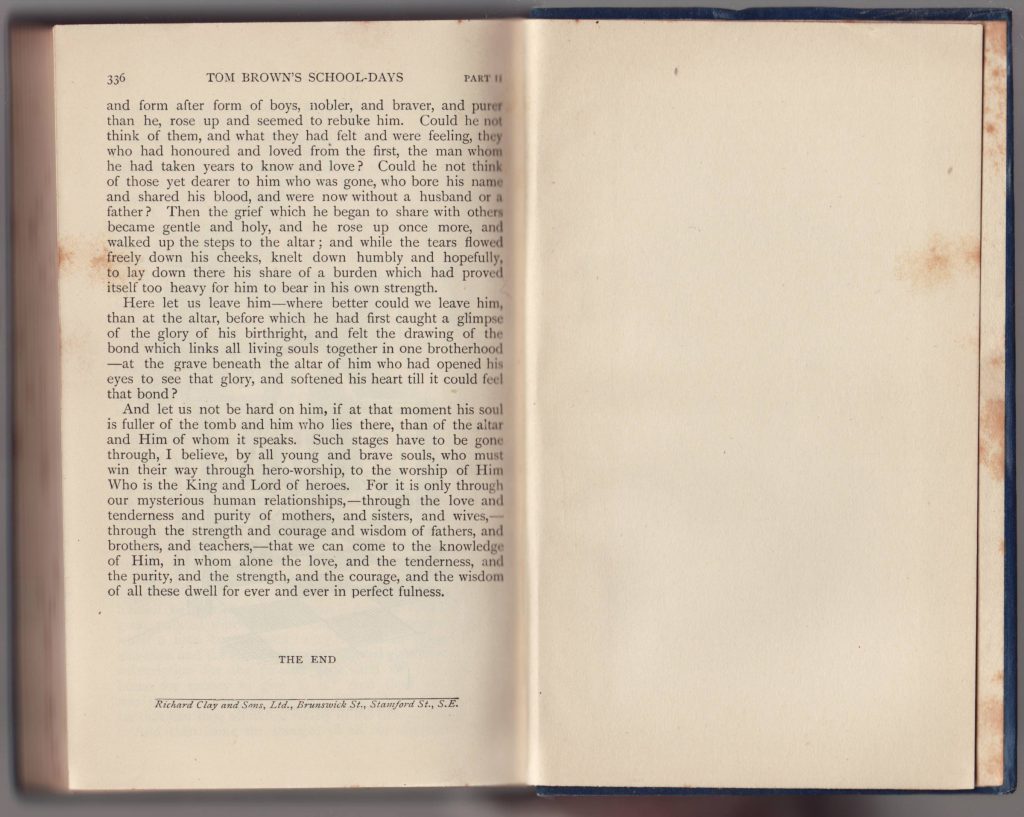Sub-series: Illustrated Pocket Classics for the Young (1904-1922)
Macmillan & Co., Ltd. (London, UK; New York, US)
Series dates: 1902-1951
Size: 4.5″ x 7″, 4.5″ x 6.45″
Macmillan’s Illustrated Pocket Classics made its debut in 1902, with a sub-series, Illustrated Pocket Classics for the Young, in first appearing in 1904. After the late teens, the sub-series name disappears although some of its titles remain available as part of the regular series. Macmillan also offered an Illustrated Pocket Dickens and Illustrated Pocket Scott series.
1904 and 1907 advertisements (below) for the Illustrated Pocket Classics and Pocket Classics for the Young series provide details about the titles, bindings, and cost:

The illustrators for most titles are indicated in the advertisement.
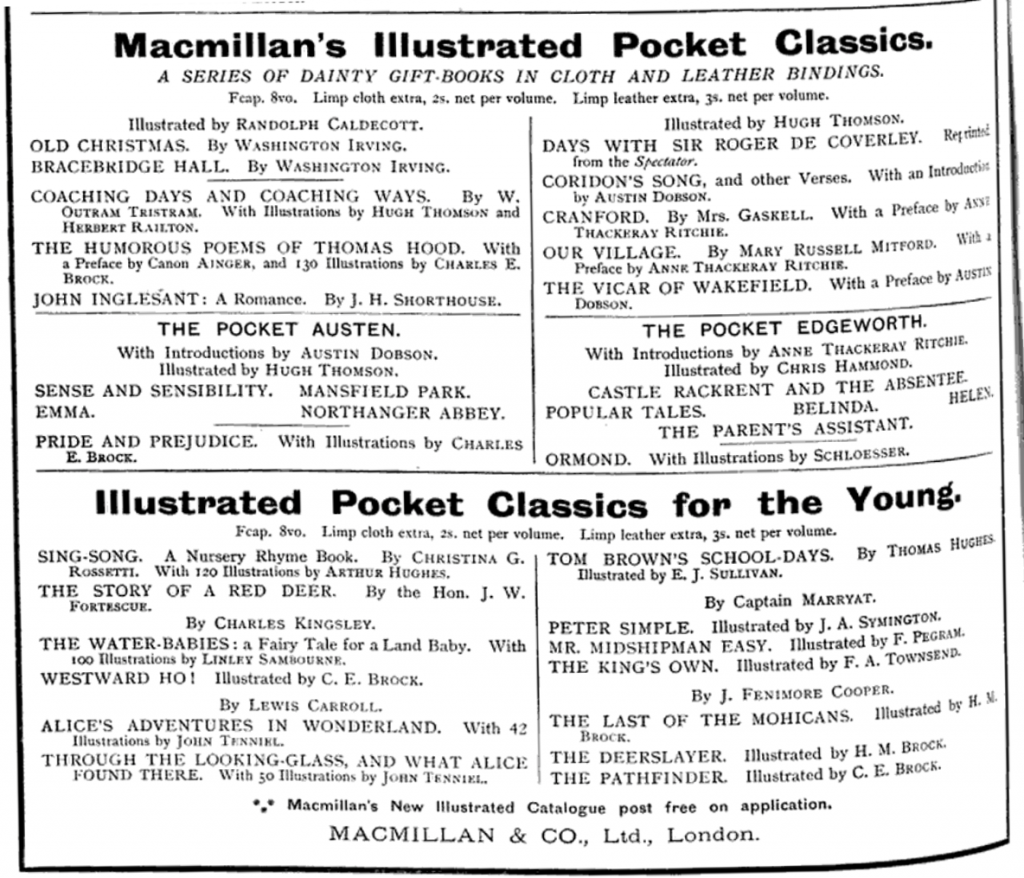
Tentative list of titles in the Macmillan Illustrated Pocket Classics is below. This accounting includes 50 titles, one of which may be a ghost title (advertised, but not issued). I’m guessing that the Lord Avebury titles (The Pleasures of Life, The Use of Life), which are sometimes listed with the series, were actually part of the Macmillan Pocket Classics. An additional 13 titles were initially issued as part of the Illustrated Pocket Classics for the Young. Thus 63 titles total in the series, with one possible ghost title.
The majority of titles were published from 1902-1908, with a break until 1924-1928 when another group of new titles was published. Reprints can be found as late as 1951.
*1902: Jane Austin, Emma (illus. by Hugh Thompson)
*1902: Jane Austin, Mansfield Park (illus. by Hugh Thompson)
*1902: Jane Austin, Northanger Abbey & Persuasion (illus. by Hugh Thompson)
*1902: Jane Austin, Pride and Prejudice (illus. by Charles E. Brock)
*1902: Jane Austin, Sense and Sensibility (illus. by Hugh Thompson)
*1902: Mrs. Gaskell, Cranford (illus. by Hugh Thompson)
*1902: Oliver Goldsmith, The Vicar of Wakefield (illus. by Hugh Thompson)
1903: Fanny Burney, Evelina (illus. by Hugh Thompson)
*1903: Maria Edgeworth, Belinda (illus. by Chris Hammond)
*1903: Maria Edgeworth, Helen (illus. by Chris Hammond)
*1903: Maria Edgeworth, Ormond (illus. by Carl Schloesser)
*1903: Maria Edgeworth, The Parent’s Assistant (illus. by Chris Hammond)
*1903: Maria Edgeworth, Popular Tales (illus. by Chris Hammond)
1903: Thomas Hood, The Humorous Poems (illus. by Charles E. Brock)
1903: Washington Irving, Old Christmas (illus. by Randolph Caldecott)
*1903: Mary Russell Mitford, Our Village (illus. by Hugh Thompson)
*1903: W. Outram Tristram, Coaching Days and Coaching Ways (illus. by Hugh Thompson & Herbert Railton)
1904: Coridon’s Song, and Other Verses (illus. by Hugh Thompson)
1904: Days with Sir Roger de Coverley (illus. by Hugh Thompson)
1904: Maria Edgeworth, Castle Rackrent and the Absentee (illus. by Chris Hammond)
1904: Washington Irving, Bracebridge Hall (illus. by Randolph Caldecott)
1905: J.H. Shorthouse, John Inglesant
1905: William Thackeray, The Newcomes (illus. by Richard Doyle)
1906: Washington Irving, Alhambra (illus. by Joseph Pennell)
1907: Washington Irving, Rip van Winkle (illus. by George H. Boughton)
***?1907: Lord Avebury (Sir John Lubbock), The Use of Life (not illustrated)
***?1908: Lord Avebury (Sir John Lubbock), The Pleasures of Life, Part 1 (not illustrated)
*1908: Richard Sheridan, The Rivals & The School for Scandal
*1908: Jonathan Swift, Travels Into Several Remote Nations of the World (Gulliver’s Travels) (illus. by Charles E. Brock)
1924: Annie Keary, The Heroes of Asgard (illus. by Charles Huard)
**1924: John Lockwood Kipling, Beast and Man in India
*1924: Mrs. Molesworth, Little Miss Peggy (illus. by Walter Crane)
1924: J.H. Patterson, The Man-Eaters of Tsavo and Other East African Adventures
*1925: W.S. Gilbert, The Bab Ballads (illus. by W.S. Gilbert)
*1925: W.S. Gilbert, More Bab Ballads (illus. by W.S. Gilbert)
*1926: W.S. Gilbert, Songs of Savoyard (illus. by W.S. Gilbert)
*1927: Thomas Love Peacock, Gryll Grange (illus. by F.H. Townsend)
*1927: Thomas Love Peacock, Melincourt, or, Sir Oran Haut-ton (illus. by F.H. Townsend)
*1927: Thomas Love Peacock, The Misfortunes of Elphin and Rhododaphne (illus. by F.H. Townsend)
*1927: Thomas Love Peacock, Maid Marian and Crotchet Castle (illus. by F.H. Townsend)
*1927: Thomas Love Peacock, Headlong Hall and Nightmare Abbey (illus. by F.H. Townsend)
*1928: Robert Louis Stevenson, The Black Arrow (illus. by H.M. Brock)
*1928: Robert Louis Stevenson, Catriona (illus. by H.M. Brock)
*1928: Robert Louis Stevenson, Dr. Jekyll & Mr. Hyde. Prince Otto (illus. by Edmund J. Sullivan)
*1928: Robert Louis Stevenson, Island Nights’ Entertainments; The Body Snatcher; Fables
*1928: Robert Louis Stevenson, Kidnapped (illus. by H.M. Brock)
*1928: Robert Louis Stevenson, The Master of Ballantrae (illus. by H.M. Brock)
*1928: Robert Louis Stevenson, The Merry Men (illus. by H.R. Millar)
*1928: Robert Louis Stevenson, New Arabian Nights (illus. by H.R. Millar)
*1928: Robert Louis Stevenson, Treasure Island (illus. by H.M. Brock)
*1928: Robert Louis Stevenson, Weir of Hermiston, The Misadventures of John Nicholson (illus. by Edmund J. Sullivan)
* in print in 1937
** might be a ghost title (Announced in an advertisement in The Publisher, vol. 21, 1924, p. 212. No copy with a date in the 1922-1928 range in WorldCat. Last issued in 1921 as a “Pocket Edition.”)
*** not illustrated but listed as in the series in 1919
? Both Avebury titles are initially issued as part of Macmillan’s Pocket Classics (Macmillan’s Magazine, October 1907). The Pleasures of Life is occasionally listed as part of the Illustrated Pocket Classics (WorldCat). The Use of Life appears in lists with Illustrated Pocket Classics. As neither book has illustrations, both, like the 5 volume Tennyson [see 1919 jacket below] were most likely Pocket Classics titles occasionally included in the Illustrated Pocket Classics lists.)
Tentative list of titles in the Macmillan Illustrated Pocket Classics for the Young (after 1922 these were available as part of the general series). This accounting includes 13 titles.
1902: J. Fenimore Cooper, The Last of the Mohicans (illus. by H.M. Brock)
1902: Frederick Marryat, Mr. Midshipman Easy (illus. by F. Pegram)
*1903: J. Fenimore Cooper, The Deerslayer (illus. by H.M. Brock)
*1903: J. Fenimore Cooper, The Pathfinder (illus. by Charles E. Brock)
*1903: Thomas Hughes, Tom Brown’s School Days (illus. by E.J. Sullivan)
*1904: Lewis Carroll, Alice’s Adventures in Wonderland (illus. by John Tenniel)
*1904: Lewis Carroll, Through the Looking Glass (illus. by John Tenniel)
1904: J.W. Fortescue, The Story of a Red Deer
1904: Charles Kingsley, The Water-Babies (illus. by Charles E. Brock / Linley Sambourne)
*1904: Charles Kingsley, Westward Ho! (Illus. by Charles E. Brock)
*1904: Frederick Marryat, The King’s Own (illus. by F.A. Townsend)
*1904: Frederick Marryat, Peter Simple (illus. by J.A. Symington)
1904: Christina G. Rosetti, Sing-Song: A Nursery Rhyme Book (illus. by Arthur Hughes)
* in print in 1937
First issued in the Illustrated Pocket Classics for the Young sub-series in 1904, J.W. Fortescue’s The Story of a Red Deer serves as an example of a title that was reassigned to the regular series when the “for the Young” series was phased out in the late teens. The book is dated 1919. The title, originally published by Macmillan in 1897, appeared in a few Macmillan series, including the Caravan Library (in the late 1920s).
This early version of the regular series jacket includes the book title and Macmillan colophon on the front of the jacket (and not the series name, as later) along with the title, author and publisher and a decorative arts-and-crafts element that also appears on the bookbinding. The front jacket flap is blank. Later jackets listed some of the titles in the series on the front jacket flap.
The rear of the jacket lists titles in the series. This is not a complete list but probably representative of titles available when the book was printed (1919). At the bottom of the list are a few odd titles, under “Without Illustrations.” Two of these are the Lord Avebury (John Lubbock) titles The Pleasures of Life and The Use of Life. The Pleasures of Life (1908) shows up as part of the series (despite the lack of illustrations) in a few contemporary sources. The Use of Life is not as clear. That title was issued by Macmillan in 1907 in the same size and format as the Illustrated Pocket Classics, but WorldCat does not list it as part of the series. I have also not seen the title in contemporary lists of titles in the series. For now, this title can be left as a possible title in the series. Below the Lord Avebury titles are The Works of Lord Tennyson in five volumes. These were issued as part of Macmillan’s Pocket Classics, a series that was published the approximately same years as the Illustrated Pocket Classics. WorldCat does list these titles as being in the Pocket Classics, not the Illustrated Pocket Classics. The fact that MacMillan included titles in a related series (but not the Illustrated series) in this list suggests that The Use of Life title may have also been in the Pocket Classics series.
Bindings are in blue cloth, with gold typography and printing. The design of the spine mimics that on the jacket spine. The Macmillan colophon also mimics that on the jacket but is debossed on the front cover.
The half-title page:
On the reverse of the half-title page is another Macmillan colophon and a listing of its various companies and offices around the world.
The title page with a facing illustration. The title page is outlined in blue, and the date is included under the publisher’s imprint.
An extensive list of publication dates and editions is included on the copyright page. The Story of a Red Deer was first published by Macmillan in 1897, reprinted 8 times through 1904, then included in the Illustrated Pocket Classics for the Young. In that sub-series or the Illustrated Pocket Classics, the title was reprinted six more times (this printing is the sixth, in 1919).
The dedication continues:
The finish of the dedication and the 3rd title page:
The first page of text. The letters at the bottom of the page may be indicators of the printed signatures in the book, and used by the binder to assemble the book in the correct order.
The last page in the book includes printer information, R. Clay and Sons.
The jackets and bindings for the Illustrated Pocket Classics and Illustrated Pocket Classics for the Young were similar in the 1904-1920 era, the only difference being the titles advertised on the rear of the jacket. Both the main and subseries seemed to share the same jacket and book design.
This copy of Tom Brown’s School-Days is dated 1911. The jacket, as is common in the late 1800s and early 1900s, replicates the patterns and typography on the book itself. The book title, a spine-length design, the publisher, and a price (2/- net) are included on the spine. A Macmillan colophon is centered on the jacket front. The jacket flaps are blank.
The rear of the jacket lists 13 titles, all that were ever issued in the sub-series. This sub-series was aimed at what we would call “young adult” today. For Tom Brown’s School Days, the author, Thomas Hughes, is listed. His name is not in or on the book itself.
This copy of Tom Brown is in the cloth binding, blue with gold decorations and typography (repeated from the jackets). The Macmillan colophon is debossed on the front of the book.
The half title page:
On the reverse of the half-title page is the Macmillan imprint, with its UK, India, Australia, US and Canada divisions listed.
An illustrated frontispiece faces the title page. Both pages are outlined in blue. The author here is indicated as “An Old Boy.” The illustrator, Edmund Sullivan, is included. The date is below the London and New York imprints.
The copyright page indicates first printing in the series in 1904, with reprints in 1906 and 1911.
The first page of text:
The books were printed by Richard Clay & Sons, Ltd.
This copy of W.S. Gilbert’s The Bab Ballads was first issued in the series in 1925 (with the companion volume More Bab Ballads). This copy is the 6th printing in the series, and is dated 1937. This jacket and book are indicative of the jacket and book design used near the end of the series availability.
This book is .25″ shorter than the Tom Brown book above.
The jackets are common to the series. The jacket spine design (replicated on the book itself) has shrunk from the full spine design used on the copy of Tom Brown’s School-Days (above). The series name is included at the top of the front of the jacket (it wasn’t on the Tom Brown title, published in 1911). A sticker with the Macmillan New York imprint is placed on the front of the jacket. It is possible this is covering a price (which would be 3s./6d.). Macmillan in the UK and in the US were essentially independently run, but they did share stock (as this title indicates). The front jacket flap includes the book prices (cloth for 3s./6d. and leather for 5s.). A list of titles available in 1937 continues from the rear flap of the jacket.
The back of the jacket includes, again, book prices and begins a list of available titles that continues on the rear flap, and then the front flap.
Bindings have been simplified from the era of the Tom Brown title above: gone is the decoration on the front of the book, and the spine decoration has been reduced.
The design of the half-title page remains the same from the earlier book:
The boxed, in color, title page design also continues from the earlier book. The date (1937) is included under the Macmillan, London imprint.
The copyright page indicates: “Transferred to Macmillan and Co., Ltd, 1904” then “First published in Illustrated Pocket Classics in 1925” then “Reprinted 1926, 1927, 1930, 1934, 1937.” The book was printed by R & R Clark, Edinburgh, UK.
The first page of text:
The last three pages of the book have a catalog of titles in the series.



